You can eliminate static cling from fabric through several easy methods. Add white vinegar to your rinse cycle, or use wool dryer balls to reduce friction during drying. For immediate relief, run a damp cloth over clingy garments or spray them with a mixture of water and fabric softener. Don't over-dry your clothes, as this increases static buildup, and try to maintain indoor humidity levels between 30-50%. Simple household items like aluminum foil balls in the dryer or safety pins attached to seams can effectively discharge static electricity. These practical solutions are just the beginning of your static-free laundry journey.
Understanding the Science of Static
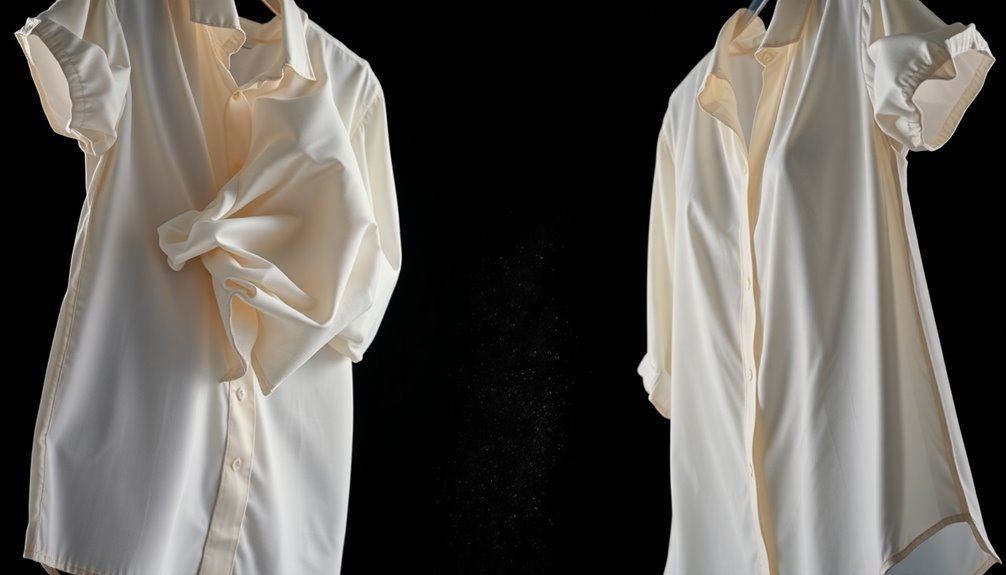
Static cling occurs through a process called the triboelectric effect, where fabrics transfer electrons as they rub against each other. When two materials come into contact, especially in dry conditions, one fabric gains electrons and becomes negatively charged, while the other loses electrons and becomes positively charged.
These opposite charges create an attraction between the fabrics, causing them to stick together. The combination of heat and friction inside your dryer creates ideal conditions for electrical charges to accumulate on clothing.
You'll notice static cling more frequently in dry environments and when wearing synthetic fibers like polyester or nylon. These materials are particularly prone to electron transfer.
The problem becomes even more noticeable when you over-dry your clothes, as the extended heating and friction in your dryer create the perfect conditions for static buildup. The lack of moisture in the air compounds this effect, as humidity typically helps dissipate electrical charges and prevent static from accumulating on your clothes.
Natural Fabric Softening Methods
Looking beyond traditional fabric softeners, you'll find several natural alternatives that effectively reduce static cling while being gentler on your clothes and the environment.
White vinegar stands out as a versatile option – simply add it to your washing machine's fabric softener compartment during the rinse cycle. You can enhance its effectiveness by mixing it with hair conditioner for a homemade fabric softener solution.
For another powerful combination, mix Epsom salt with baking soda and customize it with your favorite essential oils. This mixture helps remove detergent residue from your clothes. If you prefer a simpler approach, you can use baking soda alone.
Wool dryer balls offer a reusable solution that naturally reduces static while softening your clothes in the dryer, and soap nuts provide an all-natural washing option when placed in a cotton bag during the wash cycle.
To maximize these natural methods' effectiveness, separate your synthetic and natural fibers before washing. Consider air-drying your clothes, particularly synthetic fabrics, as this naturally minimizes static buildup.
Remember to use the appropriate amount of your chosen natural softener for each load size – too much or too little can affect the results.
Quick Fixes for Static Cling
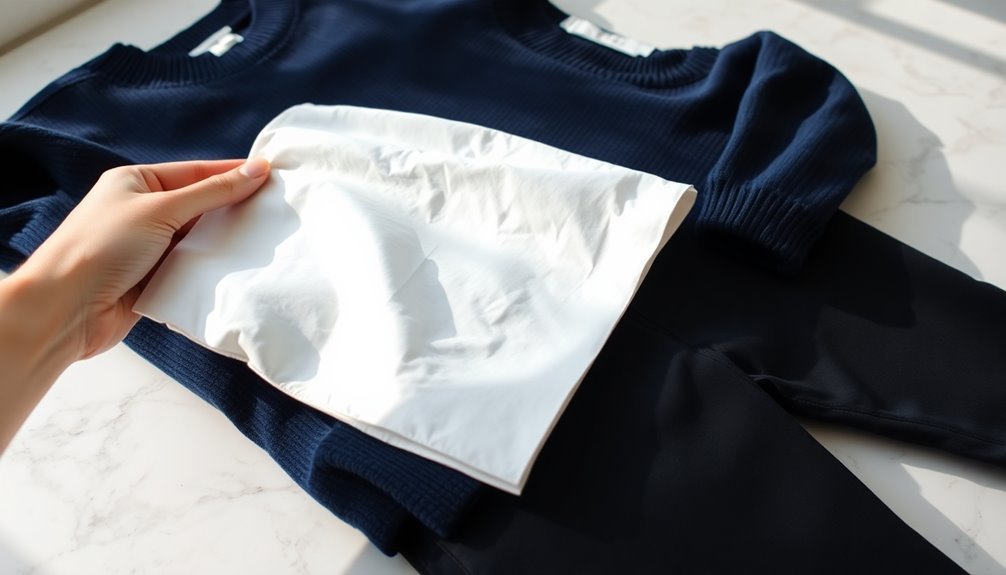
While natural fabric softening methods work well for prevention, static cling can still strike unexpectedly. When it does, you'll find several quick solutions to eliminate that annoying clinging sensation from your clothes.
For immediate relief, you can spray your garments with a static-reducing product like Static Guard or a fabric refresher spray. The best results come from spraying while holding the bottle 6 to 12 inches away from the fabric.
If you don't have these on hand, try rubbing a damp cloth or paper towel over the affected areas – the added moisture helps neutralize the electrical charges.
You can also use common household items like a wire hanger, aluminum foil, or safety pin to discharge the static electricity.
Keep your clothes static-free on the go by carrying travel-sized solutions. A small bottle of moisturizer can prevent static by adding humidity to your skin, while a dryer sheet tucked in your pocket or purse works wonders when rubbed on clingy fabrics.
For a quick fix at home, give your clothes a few strong shakes after drying, or spritz them with hairspray.
If you're dealing with persistent static, try hanging your clothes to air dry instead of using the dryer, as this naturally preserves moisture and reduces friction.
DIY Anti-Static Solutions at Home
Creating effective anti-static solutions at home can save you money and help you avoid harsh chemicals found in commercial products.
You can make several effective anti-static sprays using common household items. Mix equal parts water and white vinegar in a spray bottle, or combine one tablespoon of fabric softener with eight ounces of water and a tablespoon of isopropyl alcohol for quick-drying results. Fill small spray bottles for portability in your car or handbag.
For your dryer, you'll find multiple DIY options that work effectively. Create reusable dryer sheets by cutting cotton cloth into strips and spraying them with a vinegar-essential oil mixture.
Alternatively, toss a balled-up piece of aluminum foil into your dryer to help discharge static electricity during the drying cycle.
Don't forget about laundry additives that prevent static before it starts. Add half a cup of baking soda to your wash cycle as a natural fabric softener, or pour white vinegar into the rinse cycle.
You can also combine these methods with wool dryer balls for enhanced static reduction. These solutions are particularly effective for synthetic fabrics, which tend to generate more static electricity.
Best Laundry Practices
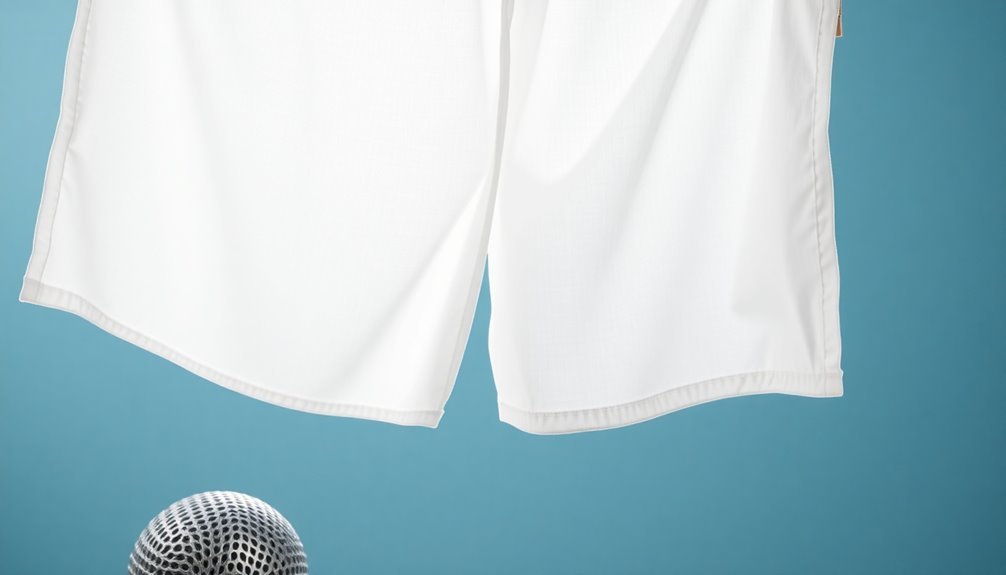
Beyond homemade solutions, proper laundry practices form the foundation of static-free clothing care. When you're washing clothes, use less detergent than you might think necessary, as excess detergent can contribute to static build-up. White vinegar and oils create a natural fabric softener when added to your wash.
Add vinegar to your rinse cycle to keep fabrics soft and reduce static potential. Always sort your clothing by fabric type, keeping synthetics separate from natural fibers throughout the washing and drying process.
During the drying cycle, you'll want to focus on these key practices:
- Remove clothes while they're still slightly damp to prevent over-drying, which is a major cause of static cling.
- Add a damp washcloth during the final 10-20 minutes of drying to maintain ideal moisture levels.
- Utilize dryer balls or aluminum foil balls to help discharge static electricity as clothes tumble.
If you have the option, air-drying your clothes is the most effective way to prevent static cling. For items that must go in the dryer, use the appropriate temperature setting and avoid mixing fabric types. If your dryer has a steam cycle, use it – the added moisture will substantially reduce static build-up in your clothes.
Choosing Static-Resistant Clothing Materials
For those seeking a permanent solution to static cling, choosing the right clothing materials makes all the difference. You'll find that polyester and carbon fiber blends offer excellent static resistance, creating a conductive fabric that effectively dissipates electrical charges. These materials meet IEC-61340-1-5 standards for proven static protection. These materials are particularly useful if you're working with electronics or in cleanroom environments.
If you're looking for comfort alongside static resistance, consider cotton and synthetic blends. These fabrics combine the breathability of cotton with the durability of materials like nylon and polypropylene, while incorporating conductive fibers to prevent static buildup.
For maximum protection, you can opt for specialized anti-static fabrics like Stark IG135. These materials feature continuous-filament polyester fibers that create permanent discharge channels for static electricity.
They're certified under strict standards and offer a cotton-like feel for enhanced comfort.
If you need dual protection, choose flame-retardant anti-static fabrics. They're woven with permanent flame-retardant polyester and conductive fibers, making them ideal for environments that require both fire safety and static prevention.
These materials are particularly valuable in medical, pharmaceutical, and aerospace settings.
Dryer Sheet Alternatives
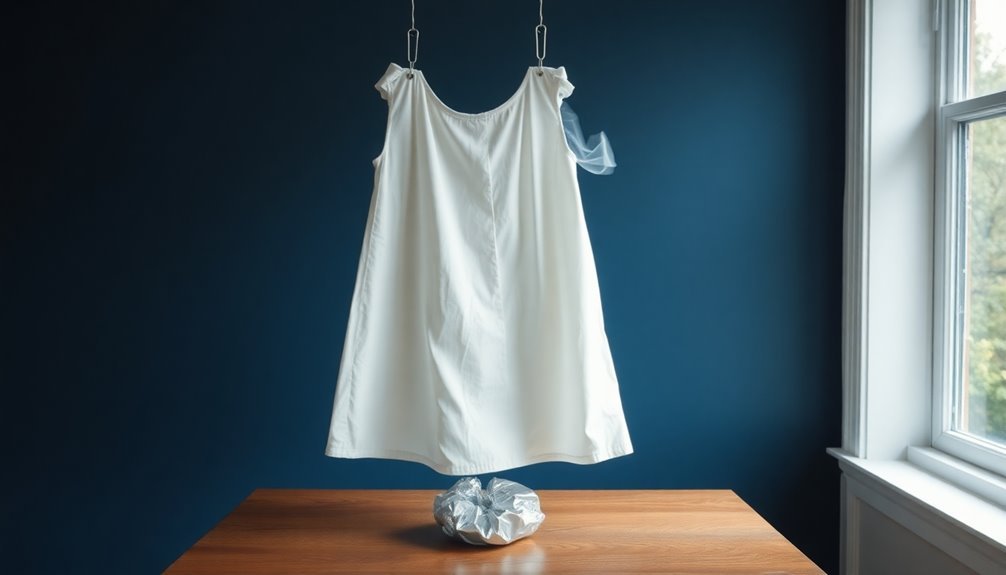
Natural wool dryer balls offer an effective alternative to chemical-laden dryer sheets, as they reduce static while naturally softening your laundry through hundreds of uses.
If you're looking for a DIY option, you can create your own fabric softening sheets by soaking clean cloths in a mixture of vinegar and water. These balls can be infused with oils for a natural fresh scent.
Both solutions help eliminate static cling while keeping your clothes fresh without harsh chemicals, though wool dryer balls have the added benefit of reducing drying time.
Natural Wool Dryer Balls
Inside the domain of eco-friendly laundry solutions, natural wool dryer balls stand as a highly effective alternative to traditional dryer sheets. These reusable balls work by absorbing moisture from your wet clothes while creating space between garments, allowing better air circulation and reducing static cling. 100% wool yarn makes these dryer balls extremely durable and resistant to unraveling over time.
You'll find they're not only eco-friendly but also cost-effective, lasting for over 1,000 uses while cutting your drying time by up to 40%.
To maximize their effectiveness in eliminating static cling, follow these key strategies:
- Use all six dryer balls regardless of load size, and don't overload your dryer – this guarantees proper movement and fabric separation.
- Set your dryer to a moisture-sensitive setting or reduce drying time to prevent over-drying, which causes static buildup.
- Consider separating synthetic fabrics from natural fibers, as synthetics are more prone to static cling.
For particularly stubborn static issues, you can enhance the balls' performance by adding a safety pin to each one or using them in conjunction with aluminum foil balls. In dry climates, try adding a bit of moisture by using vinegar in your wash cycle to further combat static electricity.
DIY Vinegar Fabric Sheets
While commercial dryer sheets often contain harsh chemicals, DIY vinegar fabric sheets offer a natural and cost-effective alternative that's simple to make at home. You'll need cotton T-shirts cut into 10-inch squares, white vinegar, essential oils, and optionally, hair conditioner.
To create these sheets, cut your old T-shirts into squares using pinking shears, then roll them tightly to fit inside a glass jar with a bail and trigger lid.
Mix 1½ cups of white vinegar with your chosen essential oils and hair conditioner, then pour this solution over the fabric squares. Let them soak overnight to guarantee proper absorption.
When doing laundry, simply toss a dampened DIY sheet into your dryer with your clothes. The vinegar works to soften fabrics and reduce static, while essential oils add a pleasant scent.
Once used, store the sheets in a separate jar until you're ready to recharge them with fresh solution. You can reuse these sheets multiple times, making them both eco-friendly and economical.
For extra static-fighting power in synthetic fabrics, consider adding vinegar directly to your wash cycle.
Humidity Control Tips
Static electricity's worst enemy is proper humidity control in your home. If you're battling stubborn static cling in your clothes, maintaining indoor humidity levels between 30% and 50% will substantially reduce the problem.
Dry air, especially during colder months, creates the perfect environment for static buildup, while proper moisture levels help neutralize those pesky electrical charges.
To effectively manage humidity and eliminate static cling, follow these essential steps:
- Install a portable humidifier in your laundry area and bedrooms to maintain ideal moisture levels, but don't exceed 60% humidity to prevent mold growth.
- Air dry your clothes when possible instead of using the dryer, as this naturally maintains fabric moisture content and reduces static electricity.
- Use a hygrometer to monitor your home's humidity levels, adjusting your humidifier settings accordingly during different seasons.
You'll notice immediate improvements in static reduction when you maintain proper humidity levels. This approach not only eliminates static cling but also protects your electronics and creates a more comfortable living environment.
For extra effectiveness, combine humidity control with other static-fighting methods like adding vinegar to your rinse cycle.
Metal-Based Static Elimination Techniques
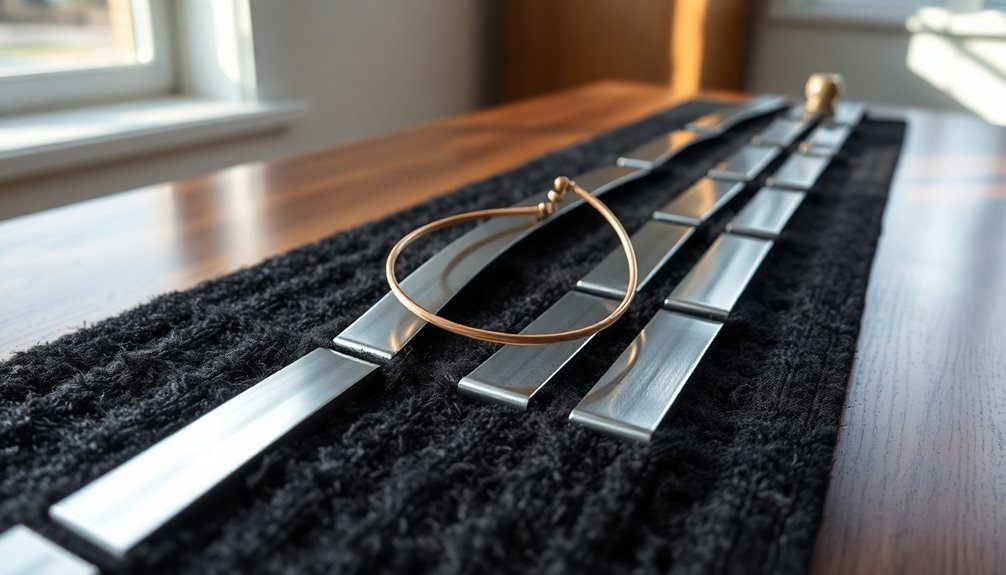
You'll find several metal-based solutions for static cling that are both effective and easy to implement at home.
Metal hangers can quickly discharge static when you slide them along your clothes, while attaching a small safety pin to the inside seam of your garments will help prevent static buildup throughout the day.
Rolling an aluminum foil ball and tossing it in your dryer during the drying cycle works as a chemical-free alternative to dryer sheets for reducing static cling.
Metal Hangers For Discharge
One of the simplest ways to combat static cling involves using metal hangers and safety pins as natural conductors. These common household items effectively neutralize static charges in your fabrics without requiring any chemicals or special treatments.
When you use metal hangers to rub over clingy fabrics, they act as mini-lightning rods, absorbing and dispersing the static electricity that causes clothes to stick together.
You'll find that metal-based static elimination is both practical and cost-effective. Here's how you can use these tools to your advantage:
- Attach safety pins to the inside seams of your garments to continuously discharge static buildup throughout the day
- Run a metal hanger over your clothing before wearing it to instantly eliminate static cling
- Place safety pins in your dryer with towels and clothes to reduce static during the drying cycle
You don't need to spend money on expensive anti-static products when you can use these reusable metal tools. The method works by allowing the metal's natural conductivity to ground the static charges, making it an environmentally friendly alternative to chemical sprays or disposable dryer sheets.
Foil Ball Method
The foil ball method stands out as an ingenious solution for banishing static cling in your dryer. To implement this technique, you'll need 3-4 square feet of aluminum foil for each ball you create.
Form the foil into tight balls about 2-3 inches in diameter, and toss two or three of them into your dryer with wet clothes.
These aluminum balls work by conducting and neutralizing the static electricity that builds up when clothes exchange electrons during the drying process. As your clothes tumble, the foil balls absorb the static charge while simultaneously keeping garments separated, which helps speed up drying time.
You'll find this method particularly appealing if you're looking to save money and reduce your environmental impact. At roughly 15 cents for three balls that last for months, it's substantially more cost-effective than traditional dryer sheets. Plus, it's completely chemical-free and reusable.
While the foil balls might make some noise during the cycle, and they're not ideal for delicate fabrics like silk or lace, they're remarkably effective for most laundry loads. Just remember to replace the balls when they become too compact or lose their shape.
Safety Pin Technique
While aluminum foil balls offer a whole-load solution, a simple safety pin provides targeted static elimination for individual garments. By attaching a safety pin to the inside seam or hem of your clothing, you'll create a mini-lightning rod that effectively discharges static electricity.
The metal pin acts as a conductor, allowing electrons to transfer and balance out, which eliminates that annoying static cling.
- Attach the safety pin to an inconspicuous inner seam to maintain your garment's appearance while letting the metal work its magic.
- Use multiple pins on larger items or those with excessive static buildup for better results.
- Consider placing a few safety pins on a small towel and tossing it in your dryer to prevent static during the drying cycle.
You can also experiment with other metal-based solutions when a safety pin isn't handy. Try running a metal spoon along the fabric's surface or using a metal hanger to discharge the static.
While this technique works particularly well on synthetic fabrics, you might want to combine it with fabric softeners or humidifiers in extremely dry conditions for maximum effectiveness.
Environmental Impact of Anti-Static Products
As consumers become more environmentally conscious, understanding the impact of anti-static products has gained critical importance. Most conventional anti-static products you'll find in stores contain non-biodegradable plastics and synthetic rubbers that pose significant threats to our ecosystems.
When you dispose of these materials, they'll remain in landfills for extended periods, contributing to the growing plastic waste crisis.
You'll be glad to know there are sustainable alternatives available. You can now choose from biodegradable plastics and natural rubber options that provide effective anti-static protection while decomposing naturally. These eco-friendly alternatives don't just benefit the environment; they'll also save you money in the long run through reduced waste management costs.
When you're selecting anti-static products, consider their complete lifecycle impact. Today's governments are implementing stricter environmental regulations, and companies are adapting by offering more sustainable options.
You'll find that environmentally responsible choices often come with lower total ownership costs due to their recyclability and compostability. By choosing sustainable anti-static solutions, you're not only addressing static cling but also contributing to environmental preservation while staying compliant with evolving regulations.
Frequently Asked Questions
Can Static Cling Damage Delicate Electronics in Clothing Pockets?
Yes, static electricity from clingy fabric can damage your electronics if they're in your pockets. You'll want to keep devices away from static-charged clothing, as the electrical discharge could harm sensitive components.
How Does Weather Affect Static Cling in Outdoor-Dried Clothes?
You'll experience more static cling during dry weather as electrical charges build up easily. In humid conditions, you'll notice less static since moisture in the air helps dissipate charges from your outdoor-dried clothes.
Do Fabric Color Choices Influence Static Cling Intensity?
No, your fabric's color won't affect static cling intensity. It's the fiber type and weather conditions that matter most. You'll find synthetic materials cling more than natural fibers, regardless of their color.
Can Static Cling Cause Sparks Strong Enough to Ignite Dryer Lint?
No, you don't need to worry about static cling causing dangerous sparks. The static electricity from your clothes isn't strong enough to ignite dryer lint. Lint fires typically start from heating elements instead.
Why Do Some People Experience More Static Cling Than Others?
You'll experience more static cling if you wear synthetic fabrics, live in dry climates, have dry skin, or use harsh laundry practices. Your personal habits and environment directly affect how much static buildup you encounter.
In Summary
Static cling doesn't have to ruin your day or your outfits. You've now got multiple options to tackle this pesky problem, from natural solutions like vinegar and aluminum foil to moisture-based fixes and proper laundry techniques. By choosing eco-friendly methods and maintaining proper humidity levels, you'll not only eliminate static but also protect your clothes and the environment. Give these techniques a try, and you'll see the difference.

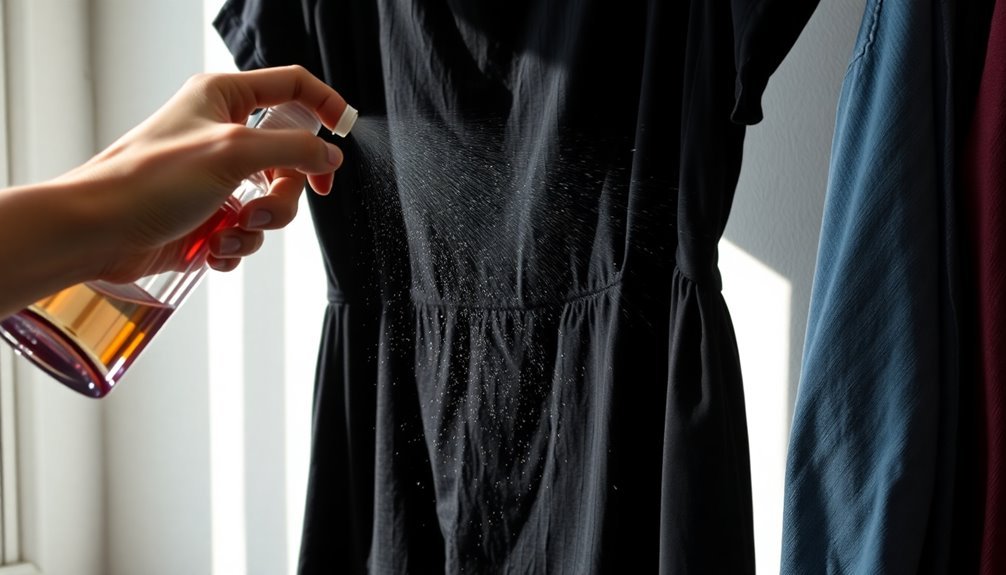



Leave a Reply